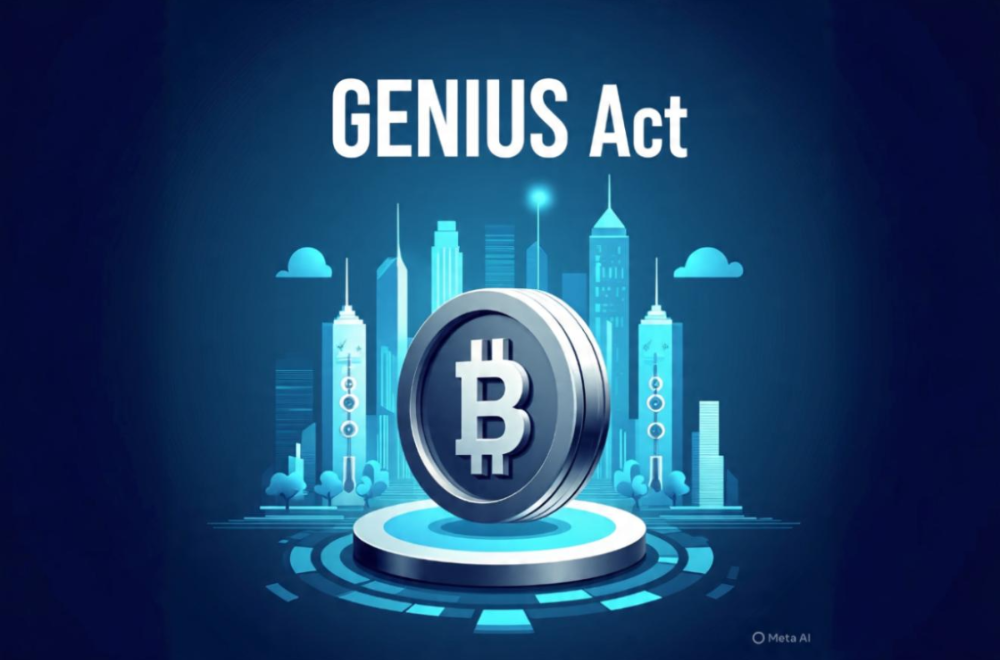Introduction
There are changes within the cryptocurrency world very rapidly. Just as stablecoins like USDT and USDC became the lifeblood of traders, so now regulators are stepping in across the globe. Meanwhile, the GENIUS Act (Guaranteeing Essential Nationwide Infrastructure for US-Stablecoins Act) has taken center stage in the U.S.
But what exactly is this Act? Why is it making headlines? And most importantly, how will it shape the future of stablecoins and digital currency?
Let’s break it all down.
What Is the GENIUS Act?

The proposed law, GENIUS Act, intends to regulate the issuance and operations of stablecoins in the United States. The year 2025 was when the legislation was introduced, and it proposes to:
- Protect consumers using stablecoins.
- Provide a clear regulatory framework for issuers.
- Enable secure integration between stablecoins and the U.S. financial system.
From instruments once considered niche, stablecoins now form part of advanced payments, remittances, and decentralized finance (DeFi). But they are also sources of concern due to claims of fraud and threats related to failure (like Terra Luna) and national security.
With bipartisan support, the GENIUS Act marks a major turning point in U.S. crypto legislation.
Key Provisions of the GENIUS Act
The GENIUS Act introduces several impactful policies:
| Provision | Summary |
|---|---|
| Licensing Requirements | All stablecoin issuers must register with the Federal Reserve or OCC. |
| 1:1 Asset Backing | Stablecoins must be backed by equivalent cash or short-term U.S. treasuries. |
| Daily Audits | Issuers must publish daily reserve reports for public review. |
| Consumer Protection | Full refunds in case of redemption failures or fraud. |
| Algorithmic Stablecoin Prohibitions | Terra-like models are not allowed until they have undergone independent assessment. |
These elements aim to achieve a balance between innovation and security.
Why Stablecoin Regulation Is Crucial
They are such digital assets, stablecoins. Unlike Bitcoin or Ethereum, the value of stablecoins does not fluctuate and is instead based on the value of a fiat currency.
However, their explosive growth poses real threats if left unregulated:
- A collapse could destabilize financial systems.
- Bad actors could launder money using untracked stablecoins.
- Lack of trust could hinder institutional adoption.
Thus, stablecoin regulation like the GENIUS Act adds legitimacy, helping both users and investors.
How the GENIUS Act Affects the Crypto Market

Since the announcement of the GENIUS Act, the crypto market has reacted with mixed emotions:
- Positive Reaction: Institutional investors welcomed the clarity. The system was praised by stablecoin issuers Circle and Paxos.
- Negative Reaction: Smaller issuers fear that compliance costs will drive them out of business.
Still, the trend shows that regulation = trust, and trust is key for mass adoption.
Example: In the month after the GENIUS Act draft leaked, USDC’s market cap grew by 15%, reflecting growing investor confidence.
Opportunities Created by Regulation
Many assume regulation stifles growth. However, in the case of stablecoins, it could unlock powerful opportunities:
| Opportunity | Benefit |
|---|---|
| Institutional Adoption | Big banks and fintech firms now feel safer entering the stablecoin space. |
| Global Payments | With clearer rules, cross-border remittances using stablecoins become faster and safer. |
| Innovation | Developers can build DeFi apps on compliant platforms, boosting creativity and functionality. |
| Financial Inclusion | A secure stablecoin ecosystem allows the unbanked to participate in digital finance. |
Thus, the GENIUS Act could act as a launchpad rather than a blockade.
Challenges and Concerns
No regulation is perfect. The GENIUS Act has also received criticism, especially from the crypto community:
- Overregulation could limit innovation.
- Licensing barriers might push projects offshore.
- Banning algorithmic stablecoins could kill potentially viable new models.
Moreover, critics argue that daily audits and real-time reporting could be too expensive for startups.
Despite this, most agree that some form of oversight is better than none at all.
Global Impact
The GENIUS Act is expected to influence global crypto regulation, much like the EU’s MiCA law did for Europe.
| Region | Reaction |
|---|---|
| Europe (EU) | May harmonize standards with the GENIUS Act to ensure cross-border compatibility. |
| Asia (Singapore, Japan) | Welcoming of strict rules; already ahead in stablecoin legislation. |
| Developing Nations | Mixed responses due to different infrastructure levels and priorities. |
Stabilization and growth of the global Web3 and DeFi ecosystems would benefit greatly under a smart regulatory framework led by the U.S.
Future of Stablecoins Post-GENIUS Act
So what lies ahead?
With the anticipated approval of the GENIUS Act in late 2025 or early 2026:
- Only fully backed, transparent stablecoins will remain competitive.
- Centralized and decentralized platforms may integrate compliant stablecoins.
- New stablecoins could be launched with compliance built in from day one.
Web3 projects will benefit most—imagine NFT marketplaces, DeFi lenders, and gaming platforms using GENIUS-compliant tokens that governments and investors trust.
Final Thoughts
The significant advancement in the regulation of cryptocurrencies is the GENIUS Act. For the first time, U.S. lawmakers are taking stablecoins in a deliberate and proactive manner. Although much remains to be done, this is potentially the bridge between extreme innovation and a secure digital economy.
Whatever you may be-investor, developer, or just interested in crypto-the GENIUS Act will be critical to your understanding of events from now in 2025 and beyond.
As Web3 continues to flourish and as digital assets now come to be mainstream, the regulated stablecoins may well become a pillar of our financial future.
FAQs
A1. The GENIUS Act (Guarding Every Nation’s Issuance of Uniform Stablecoins) is a proposed U.S. law that introduces strict rules for stablecoin issuers, ensuring each coin is backed by real assets and regulated by financial authorities.
A2. It was introduced to bring legal clarity and protect users in the growing stablecoin market, especially after concerns about unregulated issuers and risks to financial stability.
A3. Issuers must hold 1:1 fiat reserves, conduct regular third-party audits, register as licensed entities, and follow AML/KYC guidelines to operate legally in the U.S.
A4. No, the GENIUS Act is a U.S.-focused regulation, but it could influence global regulatory models as other countries may adopt similar policies.
A5. DeFi platforms using unregulated stablecoins might face restrictions, but those that adopt compliant coins could benefit from enhanced legitimacy and user trust.
A6. Many see it as a positive development that brings safety and maturity to the industry, while some believe it could limit innovation by favoring regulated players.
A7. It ensures transparency, reduces the risk of stablecoin collapse, and increases confidence by mandating audit trails and full asset backing.


1 Comment
Pingback: Stablecoins in 2025: How Big Banks Are Using Them